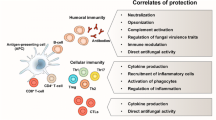Abstract
As implied by the idiotypic network theory, the interaction between the functional epitope of a microbicidal molecule (X) and its specific cell-wall receptor (RX) on sensitive microorganisms may be imaged by the bond between the idiotype (Id) of a neutralizing monoclonal antibody (anti-X Ab) and its anti-idiotype (anti-Id) X-like Ab (anti-anti-X Ab). Consequently, anti-X Ab Id may mimic RX acting as a vaccine (idiotypic vaccination) for the elicitation of protective anti-Id Abs with antibiotic activity (antibiobodies).
Access this chapter
Tax calculation will be finalised at checkout
Purchases are for personal use only
Similar content being viewed by others
References
World Health Organization (2012) Global Vaccine Action Plan 2011–2020. World Health Organization, Geneva
Arnon R, Ben-Yedidia T (2003) Old and new vaccine approaches. Int Immunopharmacol 3(8):1195–1204
U.S. Department of Health and Human Services, National Institutes of Health, National Institute of Allergy and Infectious Diseases (2008). NIH publication no. 08-4219 Understanding vaccines what they are how they work. www.niaid.nih.gov/topics/vaccines/documents/undvacc.pdf
Nascimento IP, Leite LC (2012) Recombinant vaccines and the development of new vaccine strategies. Braz J Med Biol Res 45(12):1102–1111
Rappuoli R (2000) Reverse vaccinology. Curr Opin Microbiol 3(5):445–450
Nisonoff A (1991) Idiotypes: concepts and applications. J Immunol 147(8):2429–2438
Sollner J (2016) Systems vaccinology: applications, trends, and perspectives. Methods Mol Biol 1403:107–130. doi:10.1007/978-1-4939-3387-7_5
Jerne NK (1974) Towards a network theory of the immune system. Ann Immunol (Paris) 125C(1–2):373–389
Casadevall A, Pirofski L-A (2012) A new synthesis for antibody-mediated immunity. Nat Immunol 13(1):21–28. doi:10.1038/ni.2184
Polonelli L, Morace G (1988) Yeast killer toxin-like anti-idiotypic antibodies. J Clin Microbiol 26(3):602–604
Polonelli L, Lorenzini R, De Bernardis F et al (1993) Idiotypic vaccination: immunoprotection mediated by anti-idiotypic antibodies with antibiotic activity. Scand J Immunol 37(1):105–110
Polonelli L, De Bernardis F, Conti S et al (1994) Idiotypic intravaginal vaccination to protect against candidal vaginitis by secretory, yeast killer toxin-like antiidiotypic antibodies. J Immunol 152(6):3175–3182
Guyard C, Evrard P, Corbisier-Colson AM et al (2001) Immuno-crossreactivity of an anti-Pichia anomala killer toxin monoclonal antibody with a Williopsis saturnus var. mrakii killer toxin. Med Mycol 39(5):395–400
Guyard C, Dehecq E, Tissier JP et al (2002) Involvement of β-glucans in the wide-spectrum antimicrobial activity of Williopsis saturnus var. mrakii MUCL 41968 killer toxin. Mol Med 8(11):686–694
Polonelli L, Morace G (1987) Production and characterization of yeast killer toxin monoclonal antibodies. J Clin Microbiol 25(2):460–462
Polonelli L, Conti S, Gerloni M et al (1991) “Antibiobodies”: antibiotic-like antiidiotypic antibodies. J Med Vet Mycol 29(4):235–242
Cassone A, Conti S, De Bernardis F, Polonelli L (1997) Antibodies, killer toxins and antifungal immunoprotection: a lesson from nature? Immunol Today 18(4):164–169
Torosantucci A, Bromuro C, Chiani P et al (2005) A novel glyco-conjugate vaccine against fungal pathogens. J Exp Med 202(5):597–606
Polonelli L, Séguy N, Conti S et al (1997) Monoclonal yeast killer toxin-like candidacidal anti-idiotypic antibodies. Clin Diagn Lab Immunol 4(2):142–146
Magliani W, Conti S, De Bernardis F et al (1997) Therapeutic potential of antiidiotypic single chain antibodies with yeast killer toxin activity. Nat Biotechnol 15(2):155–158
Magliani W, Conti S, Frazzi R et al (2005) Protective antifungal yeast killer toxin-like antibodies. Curr Mol Med 5:443–452
Polonelli L, De Bernardis F, Conti S et al (1996) Human natural yeast killer toxin-like candidacidal antibodies. J Immunol 156(5):1880–1885
Conti S, Fanti F, Magliani W et al (1998) Mycobactericidal activity of human natural, monoclonal, and recombinant yeast killer toxin-like antibodies. J Infect Dis 177(3):807–811
Séguy N, Cailliez JC, Delcourt P et al (1997) Inhibitory effect of human natural yeast killer toxin-like candidacidal antibodies on Pneumocystis carinii. Mol Med 3(8):544–552
Laemmli UK (1970) Cleavage of structural proteins during assembly of head of bacteriophage T4. Nature 227(5259):680–685
Guyard C, Séguy N, Cailliez JC et al (2002) Characterization of a Williopsis saturnus var. mrakii high molecular weight secreted killer toxin with broad-spectrum antimicrobial activity. J Antimicrob Chemother 49(6):961–971
Lowry OH, Rosebrough NJ, Farr AL, Randall RJ (1951) Protein measurement with the Folin phenol reagent. J Biol Chem 193(1):265–275
Pericolini E, Gabrielli E, Ballet N et al (2016) Therapeutic activity of a Saccharomyces cerevisiae-based probiotic and inactivated whole yeast on vaginal candidiasis. Virulence. doi:10.1080/21505594.2016.1213937
Polonelli L, Morace G (1986) Reevaluation of the yeast killer phenomenon. J Clin Microbiol 24(5):866–869
Polonelli L, Dettori G, Cattel C, Morace G (1987) Biotyping of mycelial fungus cultures by the killer system. Eur J Epidemiol 3(3):237–242
Morace G, Dettori G, Sanguinetti M et al (1988) Biotyping of aerobic actinomycetes by modified killer system. Eur J Epidemiol 4(1):99–103
Polonelli L, Menozzi MG, Campani L et al (1992) Anaerobic yeast killer system. Eur J Epidemiol 8(3):471–476
Polonelli L, Beninati C, Teti G et al (2014) Yeast killer toxin-like candidacidal Ab6 antibodies elicited through the manipulation of the idiotypic cascade. PLoS One 9(8):e105727. doi:10.1371/journal.pone.0105727
Polonelli L, Fanti F, Conti S et al (1990) Detection by immunofluorescent anti-idiotypic antibodies of yeast killer toxin cell wall receptors of Candida albicans. J Immunol Methods 132(2):205–209
Author information
Authors and Affiliations
Corresponding author
Editor information
Editors and Affiliations
Rights and permissions
Copyright information
© 2017 Springer Science+Business Media LLC
About this protocol
Cite this protocol
Polonelli, L., Magliani, W., Conti, S. (2017). Idiotypic Antifungal Vaccination: Immunoprotection by Antiidiotypic Antibiotic Antibodies. In: Kalkum, M., Semis, M. (eds) Vaccines for Invasive Fungal Infections. Methods in Molecular Biology, vol 1625. Humana Press, New York, NY. https://doi.org/10.1007/978-1-4939-7104-6_8
Download citation
DOI: https://doi.org/10.1007/978-1-4939-7104-6_8
Published:
Publisher Name: Humana Press, New York, NY
Print ISBN: 978-1-4939-7103-9
Online ISBN: 978-1-4939-7104-6
eBook Packages: Springer Protocols




